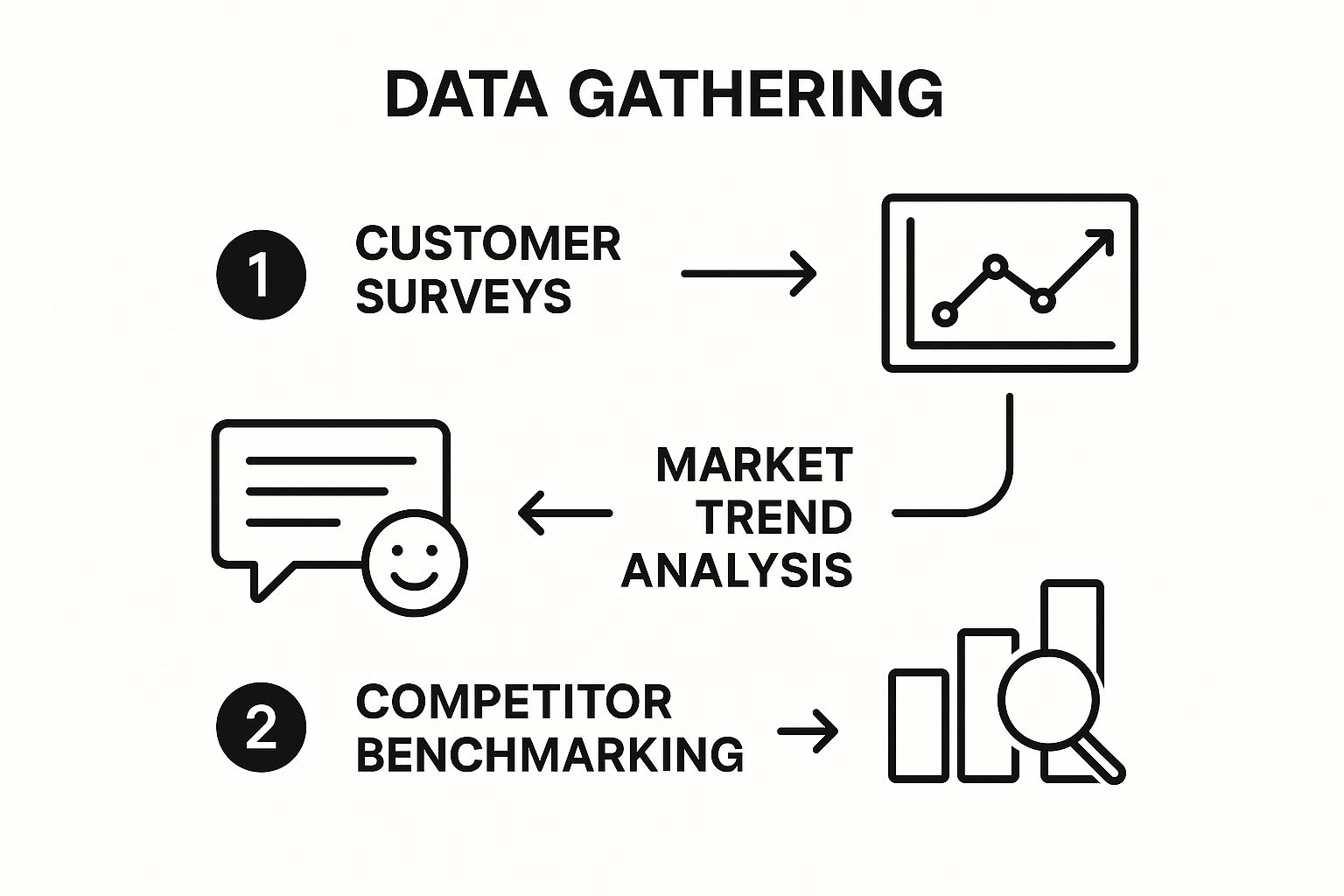Why Your Marketing Decisions Feel So Overwhelming

Let’s face it, making marketing decisions can feel like trying to pick the right path through a dense forest. You think you’ve got a clear route, then a stakeholder whispers something that makes you question everything. This constant uncertainty is the daily reality for many marketers. It’s like trying to bake a cake while the recipe keeps changing.
The Pressure Cooker of Modern Marketing
This overwhelmed feeling isn’t you; it’s the environment. The marketing decision-making process has become incredibly complicated. Think about the sheer amount of data available. We’re drowning in metrics from every platform, yet often can’t seem to find the insights we need. This data overload can make even small decisions feel huge.
The rapid pace of change adds even more complexity. New platforms pop up constantly, customer preferences shift like the wind, and algorithms are always in motion. This makes long-term planning seem almost futile, and even short-term decisions need constant review. What worked yesterday might not work today, and what works today might be gone tomorrow.
From Gut Feeling to Data-Driven Decisions
The rise of data-driven marketing, while offering incredible opportunities, has also contributed to this feeling of being overwhelmed. Many marketers struggle to turn raw numbers into actions. They may feel pressure to justify every decision with data, even when experience or intuition would be a better guide. This can lead to analysis paralysis, where the fear of choosing wrong stops you from choosing at all.
The marketing landscape in 2025 emphasizes both genuine connection and data-backed insights. Marketers now need to build real relationships while using data to guide their approach. Discover more insights into the 2025 marketing landscape.
The pressure to show return on investment (ROI) is another weight on marketers’ shoulders. Marketing isn’t a cost anymore; it’s an engine for revenue. Every decision has to be justified by its impact on the bottom line. This can create a constant feeling of being watched and judged, stifling creativity and leading to playing it safe.
Finding Clarity Amidst the Chaos
Despite these challenges, making good marketing decisions is possible. It requires a shift in thinking, from reacting to problems to proactively creating strategies. It’s about trusting your ability to navigate the complex world of modern marketing. The key is a structured approach to decision-making, one that blends data with intuition, experience, and deep customer understanding. This empowers marketers to make smart choices, even under pressure. In the following sections, we’ll explore how to achieve this clarity and build a robust marketing decision-making process that gets results.
The 5-Step Framework That Changes Everything
Think of this proven framework as a GPS for your marketing decisions. Instead of getting lost in a maze of options and opinions, you’ll have a clear route from uncertainty to confident action. We’ll walk through each step, using real-world examples from marketing teams who’ve used this process to navigate challenges like budget cuts and product launches.
Step 1: Define the Challenge
The first step in effective marketing decision-making is pinpointing the challenge. This might seem obvious, but many teams jump to solutions before truly understanding the problem. It’s like a doctor diagnosing a patient – you need to understand the symptoms before prescribing a cure. For example, if sales are down, is the core issue a lack of leads, poor conversion rates, or something else entirely? This first step is the bedrock for all that follows.
Step 2: Gather the Right Information
Once you’ve defined the challenge, it’s time to gather relevant information. This means collecting data from various sources, like customer surveys, market trend analysis, and competitor benchmarking. The infographic below visualizes this data-gathering process:

As the infographic shows, effective data gathering brings together multiple perspectives. Combining customer feedback, market trends, and competitive insights paints a more complete picture of the challenge and its potential solutions. This deeper understanding leads to smarter, more effective marketing decisions.
Step 3: Explore Potential Solutions
Armed with a clear understanding of the challenge and the right data, you can now brainstorm potential solutions. This is where creativity and innovation come in. Think outside the box and consider unconventional approaches. For instance, if your goal is boosting brand awareness, you could explore influencer marketing, content marketing, or even a guerilla marketing campaign. This exploration phase opens up new possibilities and helps identify the best strategic options.
Step 4: Evaluate Options Objectively
With a range of potential solutions, it’s crucial to evaluate them objectively. This means considering factors like budget, resources, and potential risks. A decision matrix can help compare options side-by-side. Assign weights to different criteria based on their importance to your goals. This structured approach ensures decisions are rooted in logic and data, not gut feeling. It’s especially valuable when stakeholders have differing opinions, helping everyone align on the best path forward.
Step 5: Implement and Refine
The final step is implementation and refinement. This involves putting your chosen solution into action and tracking its performance. Don’t be afraid to adjust your strategy along the way. Marketing is iterative; what works today might not work tomorrow. Regularly review results, gather feedback, and be ready to adapt. For example, if a campaign underperforms, analyze the data to pinpoint areas for improvement. This constant refinement is essential for long-term success. The power of this 5-step framework lies not just in its simplicity, but in how it adapts to different situations while keeping you strategically grounded.
To summarize the 5-step framework, let’s look at a table that breaks down each stage:
The Five Stages of Marketing Decision Making: A detailed breakdown of each stage with key activities, outputs, and success criteria
| Stage | Key Activities | Primary Output | Success Criteria |
|---|---|---|---|
| 1. Define the Challenge | Clearly articulate the problem; Analyze current performance; Conduct stakeholder interviews | Clearly defined problem statement; Documented current situation analysis | Shared understanding of the challenge among stakeholders |
| 2. Gather the Right Information | Conduct customer surveys; Analyze market trends; Benchmark competitors; Gather internal data | Comprehensive data set; Market analysis report; Customer insights report | Relevant and reliable data informing decision-making |
| 3. Explore Potential Solutions | Brainstorming sessions; Research best practices; Consult with experts; Analyze case studies | List of potential solutions; Preliminary feasibility assessment | Diverse range of potential solutions considered |
| 4. Evaluate Options Objectively | Develop a decision matrix; Weight criteria based on strategic goals; Assess potential risks and rewards; Conduct cost-benefit analysis | Selected solution with rationale; Risk mitigation plan | Data-driven decision aligned with business goals |
| 5. Implement and Refine | Develop an implementation plan; Monitor key performance indicators; Gather feedback and iterate; Adjust strategy as needed | Launched marketing initiative; Performance reports; Customer feedback data | Measurable improvement in key metrics; Continuous optimization based on data |
This table helps visualize the entire process, highlighting the key activities, expected outputs, and measures of success at each stage. By following these steps, you can create a more structured and effective approach to marketing decision-making.
Making Data Your Decision-Making Ally, Not Your Enemy

Data should be a guiding light in your marketing decisions, not a source of confusion. Many marketers, however, find themselves drowning in metrics that don’t offer clear direction. It’s like having a kitchen full of ingredients but no recipe. The real skill isn’t collecting more data; it’s about asking the right questions and focusing on the insights that actually move the needle.
From Data Overload to Actionable Insights
The sheer amount of data available can be overwhelming. We track everything from website clicks to social media engagement, yet often struggle to connect these numbers to real business goals. This can lead to analysis paralysis, slowing down decision-making instead of speeding it up. The answer lies in shifting our focus from gathering all the data to pinpointing the vital data that truly matters.
Imagine you’re launching a new product. Rather than tracking every single social media mention, focus on metrics that suggest buying intent, like clicks on product pages or items added to shopping carts. This targeted approach provides actionable insights that directly guide decisions about campaign tweaks and resource allocation.
Asking the Right Questions to Unlock Data’s Power
To get meaningful insights from data, we need to start by asking the right questions. These questions should align with our specific marketing objectives and be tailored to the choices we need to make. Think of it like having a conversation – you need to ask specific questions to get the information you want.
If your goal is to boost brand awareness, your questions might revolve around reach, impressions, and share of voice. But if your goal is to drive conversions, your questions should focus on click-through rates, conversion rates, and customer acquisition cost. By aligning your questions with your objectives, you transform data from a jumbled mess of numbers into a powerful decision-making asset. The use of Artificial Intelligence (AI) and Machine Learning (ML) is changing this process worldwide, playing a key role in analyzing consumer data and refining strategies. Learn more about global marketing trends. You might also find this interesting: Data-Driven Marketing Strategy.
Building a Data-Driven Decision-Making Culture
Creating a data-driven culture goes beyond simply collecting and analyzing data. It involves fostering open communication and collaboration within your team. Encourage team members to share their insights and challenge assumptions based on the data. This creates a feedback loop that constantly improves your marketing decision-making process, leading to smarter and more effective decisions over time.
Moreover, creating clear, easy-to-understand dashboards can help translate complicated data into straightforward recommendations that stakeholders can easily grasp. This encourages buy-in and ensures that everyone is on the same page when it comes to strategic direction. By embracing data as a trusted advisor, marketers can move from feeling overwhelmed to feeling empowered, making informed decisions that drive real results. This allows marketers to make smarter choices, allocate resources efficiently, and ultimately achieve their marketing goals.
Understanding What Really Drives Your Customers
Your customers aren’t just data points; they’re individuals with their own unique needs and motivations. Truly effective marketing understands not just what customers do, but why. It’s about looking past simple demographics and understanding what makes them tick.
Beyond Traditional Personas
Traditional customer personas often focus on demographics and buying habits. While helpful, this information only scratches the surface. Imagine knowing someone’s age and income but having no idea what their dreams are or what connects them to a brand. That’s the missing piece.
To truly understand your customers, dig deeper. Explore their values, aspirations, and pain points. What are their unmet needs? What truly resonates with them? What are they seeking in a brand relationship? For a helpful resource, check out this Customer Persona Template.
The Power of Empathy in Marketing Decisions
Empathy is crucial for good marketing decisions. By stepping into your customers’ shoes, you gain a much deeper understanding of their motivations. This allows you to craft marketing messages that resonate and address their needs directly.
For example, instead of just focusing on the practicalities of baby products, a company could focus on the joy and connection of parenthood. This emotional connection is far more powerful than simply listing product features.
Gathering Authentic Insights
Gaining valuable customer insights doesn’t require expensive research studies. There are simple yet effective methods to gather authentic information:
- Social listening: Keep an eye on social media to understand what customers are saying about your brand and your competitors.
- Customer surveys: Use targeted questions to gather specific information about customer needs and preferences.
- Focus groups: Facilitate in-depth discussions with small groups of customers to explore their thoughts and feelings in more detail.
- Customer service interactions: Analyze customer service calls and emails to identify common issues and opportunities for improvement.
These everyday interactions offer a treasure trove of information about your customers’ motivations and decision-making processes.
The Evolving Customer Journey
Customer expectations are always evolving, especially with rapid technological advancements. Today’s customers are savvy and expect personalized experiences, seamless interactions, and authentic communication. For example, by 2025, 51% of consumers will use product videos to make purchasing decisions, emphasizing the importance of visual storytelling. Discover more insights. Your marketing must adapt to these evolving needs.
From Insights to Action
Understanding your customers is just the first step. You need to turn these insights into action. This means:
- Developing targeted campaigns: Create marketing messages that speak directly to your customers’ needs and what motivates them.
- Optimizing the customer experience: Ensure smooth and easy interactions with your brand across all touchpoints.
- Building strong relationships: Focus on genuine connections that foster loyalty and advocacy.
By integrating customer insights into every step of your marketing process, you can create more effective campaigns, build stronger relationships, and ultimately achieve better results. This deeper understanding allows for informed choices that resonate with your audience and drive success.
The Decision-Making Traps That Sabotage Smart Marketers

Even the most experienced marketers can fall into common traps during the decision-making process. These pitfalls can derail even the most promising strategies. Understanding these patterns is essential to avoid costly mistakes. We’ll explore these common traps, using real-world examples and stories from marketing teams.
Analysis Paralysis: The Overthinker’s Dilemma
Have you ever spent hours agonizing over a seemingly simple decision? That’s analysis paralysis. It’s like trying to choose from a massive menu with too many appealing options. You end up so overwhelmed that you order nothing at all.
In marketing, this often happens when we’re faced with complex choices and a mountain of data. The fear of making the wrong call can be paralyzing. Ironically, this overthinking can lead to missed opportunities and stalled progress.
This doesn’t mean data is bad. It just means we need to be more discerning. Think of a chef preparing a dish: they don’t use every ingredient in the kitchen. They carefully select the ones that contribute to the desired flavor profile. Similarly, marketers need to identify the data points that are truly relevant to the decision at hand. You might be interested in: Marketing and Sales Alignment.
Confirmation Bias: Seeing What You Want to See
We all have our biases. Confirmation bias is the tendency to favor information that supports our existing beliefs, while ignoring evidence that contradicts them. Think of it like this: if you’re convinced a particular social media platform is perfect for your target audience, you might subconsciously focus on data that reinforces that belief, while overlooking negative feedback or the potential of other platforms.
This trap can keep us clinging to ineffective strategies and blind us to better alternatives. Overcoming it requires actively seeking diverse perspectives and challenging our own assumptions. Ask tough questions and be open to changing your mind based on evidence, not just gut feeling.
Groupthink: When Harmony Hinders Progress
Sometimes, the desire for team harmony can stifle critical thinking. This is groupthink. Imagine a marketing team readily agreeing on a new campaign idea simply to avoid conflict, even if some members have reservations.
This can lead to mediocre results. Healthy debate and constructive disagreement are crucial for good decision-making. Encourage team members to express their concerns and challenge assumptions—even the leader’s. This fosters a culture of open communication where the best ideas, not just the most agreeable ones, prevail.
The Pressure Cooker and Predictably Poor Choices
Tight deadlines, budget constraints, and demanding stakeholders can create a pressure cooker environment. Under stress, we’re more likely to rely on mental shortcuts and biases, leading to poor decisions. Imagine making a last-minute campaign change based on a single stakeholder’s comment without proper evaluation. Ouch.
Creating safeguards, like checklists and structured frameworks, can help maintain objectivity and prevent impulsive decisions under pressure. These tools provide a clear process to follow, ensuring key factors aren’t overlooked, even when time is tight.
Building Stronger Decision-Making Muscles
Overcoming these traps requires constant vigilance and intentional effort. It’s about developing your decision-making muscles through practice and reflection. Like any skill, improvement comes with consistent work and learning from both successes and failures.
Analyze past decisions—both good and bad—to understand what worked, what didn’t, and how to refine your approach. This ongoing process of self-reflection and continuous improvement is what distinguishes effective decision-makers from those who repeatedly fall prey to common traps.
Let’s take a closer look at some common pitfalls and solutions in the table below:
Marketing Decision Making Pitfalls and Solutions
Common mistakes marketers make and proven strategies to avoid them
| Common Pitfall | Warning Signs | Prevention Strategy | Recovery Actions |
|---|---|---|---|
| Analysis Paralysis | Inaction, missed deadlines, excessive data gathering | Set clear goals and deadlines, prioritize key data points, establish a decision-making framework | Delegate decision-making authority, break down complex decisions into smaller steps, seek external input |
| Confirmation Bias | Favoring data that supports pre-existing beliefs, dismissing contradictory evidence | Actively seek out diverse perspectives, challenge assumptions, use blind data analysis | Conduct a post-mortem analysis to identify biases, re-evaluate data with a neutral perspective |
| Groupthink | Lack of dissent, pressure to conform, illusion of unanimity | Encourage constructive disagreement, appoint a devil’s advocate, use anonymous feedback mechanisms | Facilitate open discussions, revisit alternative options, bring in outside perspectives |
| Pressure Cooker Decisions | Impulsive choices, lack of thorough evaluation, reliance on gut feelings | Build safeguards (checklists, frameworks), establish clear decision-making processes, delegate appropriately | Conduct a thorough post-decision review, adjust processes to prevent future impulsive decisions, communicate transparently about mistakes and learnings |
By developing this awareness and adopting practical techniques, marketers can navigate the complex decision-making landscape with greater confidence and achieve better outcomes.
How Real Companies Make Marketing Decisions Under Pressure
Theory is great, but let’s be honest, nothing beats seeing how things play out in the real world, especially when the pressure’s on. Let’s dive into how successful companies, from scrappy startups to industry titans, navigate tricky marketing decisions in high-stakes situations. These real-world examples show the marketing decision-making process in action.
Dollar Shave Club: Disruption Through Simplicity
Dollar Shave Club’s incredible success story perfectly illustrates how smart marketing can shake up an entire industry. Facing off against giants like Gillette, Dollar Shave Club didn’t try to win a spending war. Instead, they tapped into what customers truly wanted: simple, affordable razors. Their now-famous YouTube video, made for just $4,500, went viral, proving the impact of a sharp message and smart targeting. This bold move, fueled by understanding customer needs and challenging traditional marketing, launched them to the top.
Airbnb: Pivoting Through Crisis
The COVID-19 pandemic threw a curveball at Airbnb. Travel restrictions brought their core business to a screeching halt. But instead of panicking, Airbnb shifted gears, focusing on local experiences and longer stays. This quick thinking, based on a deep understanding of changing customer needs, helped them weather the storm and emerge even stronger. They adapted their marketing decision-making process to prioritize flexibility and responsiveness. It’s a testament to how even established companies can thrive during challenging times with a data-driven, customer-centric approach.
Small Brands, Big Wins: Strategic Focus
Smaller brands often face an uphill climb against bigger competitors. Their success hinges on making clever, targeted decisions. Imagine a local bookstore competing with Amazon. They might focus on community building, personalized recommendations, and author events. These choices, tailored to a specific customer group, allow small businesses to stand out and thrive even in competitive markets. Their strategic decision-making is all about knowing their strengths and aligning them with customer needs.
Learning from Setbacks and Iterating Forward
These aren’t just shiny success stories; they’re about recognizing what didn’t work too. Dollar Shave Club had logistical growing pains. Airbnb navigated changing regulations and traveler preferences. Small businesses constantly tweak their strategies based on customer feedback and market trends. The key takeaway is to see setbacks as learning opportunities. Refine the marketing decision-making process and iterate towards better solutions. This constant adaptation is the secret to long-term success in a dynamic market. Examining these real-world examples gives us practical insights into how companies make tough marketing decisions, overcome challenges, and achieve significant results. These stories offer valuable lessons in applying strategic decision-making to our own marketing puzzles, highlighting the impact of a solid process and a customer-focused approach.
Building Your Decision-Making Toolkit That Actually Gets Used
Marketing frameworks are great in theory, but they’re useless gathering dust on a shelf. They need to be actively used to be effective. This section focuses on practical application, giving you ready-to-use tools to improve your day-to-day marketing decisions. Think of it as equipping your team with the tools they need to succeed. We’ll explore templates, checklists, and frameworks used by successful marketing teams, and provide guidance on choosing the right tool for the job.
Practical Tools for Effective Decisions
Imagine a toolbox. Inside, you have just the right tool for every repair job. We’re going to build that same kind of toolbox for your marketing decision-making process. Here’s what you’ll get:
- Customizable Decision Matrices: These matrices help you objectively compare different options. You assign scores to criteria based on their importance, making complex decisions easier to understand and more transparent. It’s like having a clear scoring system for your marketing choices.
- Stakeholder Analysis Templates: Successful marketing considers everyone affected. These templates help you identify who’s involved, what their needs are, and how much influence they have. It’s like creating a map of your marketing landscape.
- Simple Evaluation Frameworks: These frameworks guide you through evaluating the potential impact and risks of your marketing strategies, allowing you to make smart choices that align with your overall goals. Think of these frameworks as your strategic compass.
These tools are designed to make your current processes easier, not more complicated. They are meant to be practical additions to your workflow.
Adapting Tools to Your Team’s Needs
Just like a carpenter chooses different tools for different woods, your marketing toolkit needs to be adaptable. There is no one-size-fits-all solution. You’ll learn how to adjust these resources to your team’s specific needs, the industry you operate in, and your unique company culture.
For example, a small startup might adapt a decision matrix to focus on quick, budget-friendly solutions, while a larger corporation might use it to evaluate long-term brand building and return on investment (ROI).
Implementing and Training Your Team
Rolling out new tools effectively requires planning and training. We’ll discuss practical ways to:
- Training Your Team: Clear and concise training is crucial. Focus on how to use each tool in everyday situations. Make it practical and relevant.
- Establishing Standards: Setting clear decision-making standards creates consistency across projects. This minimizes confusion and brings everyone on the same page.
- Documenting Lessons: Keep track of your decisions and the outcomes. This creates a valuable knowledge base for future decisions, turning each choice into a learning opportunity.
By the end of this section, you’ll have a complete toolkit of proven methods to make good decision-making a systematic, repeatable process. You’ll also have the confidence to put these tools to work with your team. Making good decisions shouldn’t feel like luck; it should be a skill you can develop and use consistently.
Ready to improve your marketing decision-making? ReachLabs.ai provides expert advice and data-driven insights to help you make smarter choices and achieve exceptional results. Visit ReachLabs.ai today to learn more.





